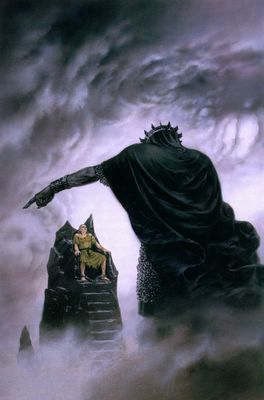
(Húrin on Thangorodrim [Ted Nasmith])
Tolkien loved archaic language, in which he often used far beyond the tolerance of the modern reader, when he wrote alliterative verse. He sometimes succumbed to all the temptations the alliterative form offers to a literary scholar: the opportunity to use archaic words to meet the alliterative requirements, the temptation to distort the syntax to meet the rhythmic demands of Anglo-Saxon alliterative meter, and various other sins less besetting, such as the temptation to include filler material for the sake of the meter. However, once tuned into Tolkien's world, the difficulties fall away in a plethora of wonderful, and often terrifying images:
Then Thalion was thrust to Thangorodrim,
that mountain that meets the misty skies
on high o'er the hills that Hithlum sees
blackly brooding on the borders of the north,
To a stool of stone on its steepest peak
they bound him in bonds, an unbreakable chain,
and the Lord of Woe there laughing stood,
then cursed him for ever and his kin and seed
with a doom of dread, of death and horror.
There the mighty man unmoved sat;
but unveiled was his vision, that he viewed afar
all earthly things with his eyes enchanted
that fell on his folk- a fiend's torment.
(The Lay of the Children of Húrin, lines 92-104)




No comments:
Post a Comment